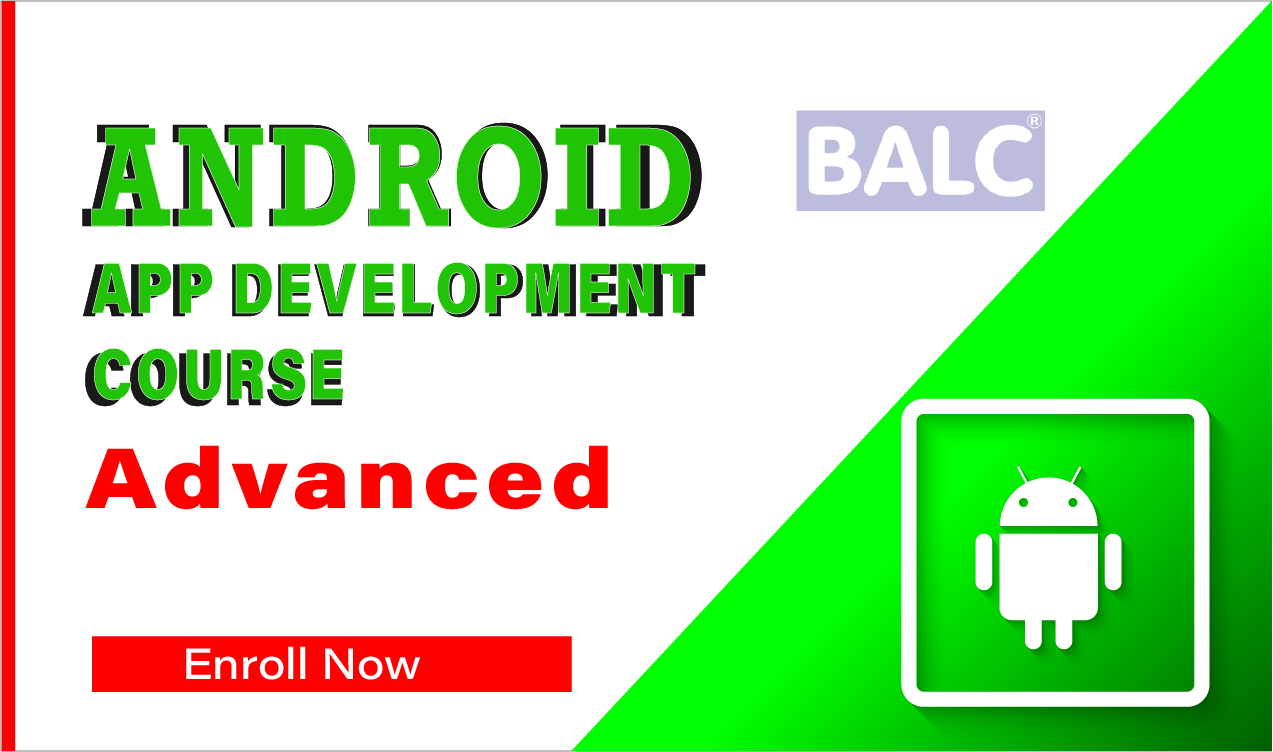COURSE Detail
BALC Courses


Courses Overview
For better career options Android App Development Course is best choice.
There is a huge demand for Android app developers.
Placement assistance.
For better career options Android App Development Course is best choice.
There is a huge demand for Android app developers.
Placement assistance.
Course Duration: 100 hours
Week Day / Weekend and Online Batches available
Eligibility B.TECH. (CS/IT/EC) or MCA/M.Sc. (IT/CS/ Electronics), BCA/PGDCA, Diploma in Computer/Electronics Stream,
B.Sc. etc.
Knowledge of JAVA programming is required.
Chapter 1 : OOPS Concepts
• Inheritance in detail
• Exception handling
• Packages & interfaces
• JVM & .jar file extension
• Multi-threading (Thread class & Run able Interface)
Chapter 2: SQL
• DML & DDL Queries in brief
Chapter 3: Introduction to Android
• What is Android?
• Setting up development environment
• Dalvik Virtual Machine & .apk file extension
• Fundamentals:
• Basic Building blocks - Activities, Services,
Broadcast Receivers & Content providers
• UI Components - Views & notifications
• Components for communication -Intents & Intent
Filters
• Android API levels (versions & version names)
Chapter 4: Application Structure (in detail)
• AndroidManifest.xml
• Uses-permission & uses-sdk
• Resources & R.java
• Assets
• Layouts & Drawable Resources
• Activities and Activity lifecycle
• First sample Application
Chapter 5: Emulator-Android Virtual Device
• Launching emulator
• Editing emulator settings
• Emulator shortcuts
• Logcat usage
• Introduction to DDMS
• Hello World App
• Creating your first project
The manifest file
Layout resource
Running your app on Emulator
• Second App:- (switching between activities)
• - Develop an app for demonstrating the
communication between Intents
Chapter 6: Basic UI design
• Form widgets
• Text Fields
• Layouts
• [dip, dp, sip, sp] versus px
• Examples
Chapter 7: Preferences
• Shared Preferences
• Preferences from xml
• Examples
Chapter 8: Menu
• Option menu
• Context menu
• Sub menu
• menu from xml
• menu via code
• Examples
Chapter 9: Intents (in detail)
• Explicit Intents
• Implicit intents
• Examples
Chapter 10: UI design
• Time and Date
• Images and media
• Composite
• Alert Dialogs & Toast
• Popup
• Examples
Chapter 11: Tabs and Tab Activity
• Examples
Chapter 12: Styles & Themes
• styles.xml
• drawable resources for shapes, gradients
(selectors)
• style attribute in layout file
• Applying themes via code and manifest file
• Examples
Chapter 13: Content Providers
• SQLite Programming
• SQLiteOpenHelper
• SQLiteDatabase
• Cursor
• Reading and updating Contacts
• Reading bookmarks
Chapter 14: Android Debug Bridge (adb) tool
Chapter 15: Linkify
• Web URLs, Email address, text, map address,
phone numbers
• MatchFilter & TransformFilter
Chapter 16: Adapters and Widgets
• Adapters:-
• a. ArrayAdapters
• b. BaseAdapters
• ListView and ListActivity
• Custom listview
• GridView using adapters
• Gallery using adapters
Chapter 17: Notifications
• Broadcast Receivers
• Services and notifications
• Toast
• Alarms
Chapter 18: Custom components
• Custom Tabs
• Custom animated popup panels
• Other components
Chapter 19: Threads
• Threads running on UI thread (runOnUiThread)
• Worker thread
• Handlers & Runnable
• AsynTask (in detail)
• Examples
Chapter 20: Advanced
• Live Folders
• Using sd cards
• XML Parsing
• JSON Parsing
• Maps, GPS, Location based Services
• Accessing Phone services (Call, SMS, MMS)
• Network connectivity services
• Sensors
Chapter 21: Services
• Overview of services in Android
• Implementing a Service
• Service lifecycle
• Inter Process Communication (AIDL Services)
Chapter 22: Multimedia in Android
• Multimedia Supported audio formats
• Simple media playback
• Supported video formats
• Simple video playback
Chapter 23: Location Based Services and Google Maps
• Using Location Based Services
• Finding current location and listening for changes
in location
• Proximity alerts
• Working with Google Maps
• Showing google map in an Activity
• Map Overlays
• Itemized overlays
• Geocoder
• Displaying route on map
Chapter 24: Sensors
• How Sensors work
• Using Orientation and Accelerometer sensors
• Best practices for performance
Chapter 25: WiFi
• Monitoring and managing Internet connectivity
• Managing active connections
• Managing WiFi networks
Chapter 26: Telephony Services
• Making calls
• Monitoring data connectivity and activity
• Accessing phone properties and status
• Controlling the phone
• Sending messages
Chapter 27: Camera
• Taking pictures
• Media Recorder
• Rendering previews
Chapter 28: Bluetooth
• Controlling local Bluetooth device
• Discovering and bonding with Bluetooth devices
• Managing Bluetooth connections
• Communicating with Bluetooth
Chapter 29: Testing and Debugging Android Application
• Role and Use of Dalvik Debug Monitor Server
(DDMS), How to debug android application
• Use of Step Filters, Breakpoints, Suspend and
Resume
Chapter 30: Android Application Deployment
• Android Application Deployment on device with
Linux and Windows
Android Application Deployment on Android
Market
Chapter 31: Basics of Android Secure Coding
• Security Tips
• Storing Data
• Using Networking
• Android Permissions
• Intents
• Broadcast Receiver
• Activities
• Content Providers
• Files
INR 60000/-





